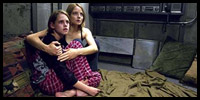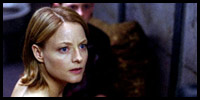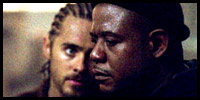
 |
Panic Room (2002) Directed by David Fincher Cast: Jodie Foster, Kristen Stewart, Forest Whitaker, Dwight Yoakam, Jared Leto, Patrick Bauchau, Ann Magnuson, Ian Buchanan, Paul Schulze, Mel Rodriguez 2002 – 109 minutes Rated: Reviewed by Dustin Putman, March 31, 2002.  A superb exercise in eliciting suspense out of simple, progressively sticky situations, "Panic Room" is a taut, exciting thriller. That the film primarily takes place inside a single room over one night and still obtains the ability to rachet up almost unbearable tension is a testament to the superior filmmaking abilities of director David Fincher (1999's "Fight Club").
A superb exercise in eliciting suspense out of simple, progressively sticky situations, "Panic Room" is a taut, exciting thriller. That the film primarily takes place inside a single room over one night and still obtains the ability to rachet up almost unbearable tension is a testament to the superior filmmaking abilities of director David Fincher (1999's "Fight Club"). Meg Altman (Jodie Foster) is a caring single mother going through both a painful divorce and the tedious process of searching for a new home to move into with her 14-year-old daughter, Sarah (Kristen Stewart). They seemingly find their dream house in an enormous Brownstone located on the Upper West Side of Manhattan, complete with spacious rooms, an elevator, a high-tech security system, and a place called the "panic room"--a steel-plated refuge designed to keep out intruders.
Meg Altman (Jodie Foster) is a caring single mother going through both a painful divorce and the tedious process of searching for a new home to move into with her 14-year-old daughter, Sarah (Kristen Stewart). They seemingly find their dream house in an enormous Brownstone located on the Upper West Side of Manhattan, complete with spacious rooms, an elevator, a high-tech security system, and a place called the "panic room"--a steel-plated refuge designed to keep out intruders.On their first night there, they are awakened by the sounds of three men who have just broken in. Locking themselves in the "panic room," Meg and Sarah are equipped with camera monitors that conveniently capture the goings-on in every room of the house. Thinking they may be safe if they stay there long enough, they are distressed to find that what the three dangerous men--Burnham (Forest Whitaker), Junior (Jared Leto), and Raoul (Dwight Yoakam)--want is in that very room. Making matters worse, the diabetic Sarah is growing more and more ill without her insulin shots and any sugar. Ingeniously written by David Koepp (1999's "Stir of Echoes"), "Panic Room" stands as a sterling example of how to make a thriller the right way.  Along with cinematographers Conrad W. Hall and Darius Khondji's (1999's "In Dreams") marvelously atmospheric camera work, director Fincher makes the most of a film set in such an enclosed space. One seemingly unbroken shot is especially a stunner, as it starts off with Meg in bed, travels downstairs, through the handle on a coffee pot in the kitchen, follows the intruders outside as they try to find a way into the house, and finally goes into the keyhole of the front door. Along with cinematographers Conrad W. Hall and Darius Khondji's (1999's "In Dreams") marvelously atmospheric camera work, director Fincher makes the most of a film set in such an enclosed space. One seemingly unbroken shot is especially a stunner, as it starts off with Meg in bed, travels downstairs, through the handle on a coffee pot in the kitchen, follows the intruders outside as they try to find a way into the house, and finally goes into the keyhole of the front door.Fincher also uses the life-threatening situations at hand to optimal effect, such as a sequence where the men send propane gas into the air ducts of the "panic room," and another where Meg quietly sneaks out of the room to find her cell phone, with the men right outside the door. It is clear every step of the way that "Panic Room" is more of an exercise in style than a deep, thought-provoking motion picture, but it does it extremely well.  As Meg, Jodie Foster (1999's "Anna and the King") makes for the perfect strong-willed protagonist. While her character is slimly developed, Foster is so adept at subtlety and realism in her acting style that all you really need to know about her is found in her body language and expressive facial expressions. In newcomer Kristen Stewart, you couldn't find a more dead ringer to play Foster's daughter if you tried. Luckily, the young Stewart also appears to have the acting chops to fulfill the requirements of the role. As the three thieves, the always good Forest Whitaker (2000's "Battlefield Earth") adds great depth to the most soft-spoken and humane of the trio, while Jared Leto (2000's "American Psycho") and Dwight Yoakam (1996's "Sling Blade") ably support him.
As Meg, Jodie Foster (1999's "Anna and the King") makes for the perfect strong-willed protagonist. While her character is slimly developed, Foster is so adept at subtlety and realism in her acting style that all you really need to know about her is found in her body language and expressive facial expressions. In newcomer Kristen Stewart, you couldn't find a more dead ringer to play Foster's daughter if you tried. Luckily, the young Stewart also appears to have the acting chops to fulfill the requirements of the role. As the three thieves, the always good Forest Whitaker (2000's "Battlefield Earth") adds great depth to the most soft-spoken and humane of the trio, while Jared Leto (2000's "American Psycho") and Dwight Yoakam (1996's "Sling Blade") ably support him. For all of the technical and stylistic artistry involved in bringing "Panic Room" to life (the marvelously inventive opening credits sequence is also worth noting), with the end credits comes a curious feeling of having had a fun time, but nothing more. The film doesn't really achieve much in its 109 minutes, nor does Meg or any of the other characters go through a much-needed catharsis needed to make the final moments more satisfying. Still, these minor shortcomings are a small price to pay for a film in the thriller genre that is as genuinely electrifying as "Panic Room" is.
For all of the technical and stylistic artistry involved in bringing "Panic Room" to life (the marvelously inventive opening credits sequence is also worth noting), with the end credits comes a curious feeling of having had a fun time, but nothing more. The film doesn't really achieve much in its 109 minutes, nor does Meg or any of the other characters go through a much-needed catharsis needed to make the final moments more satisfying. Still, these minor shortcomings are a small price to pay for a film in the thriller genre that is as genuinely electrifying as "Panic Room" is.
©2002 by Dustin Putman |
 |













